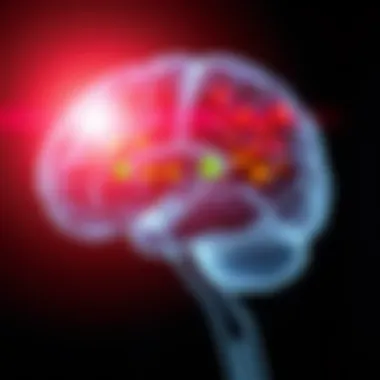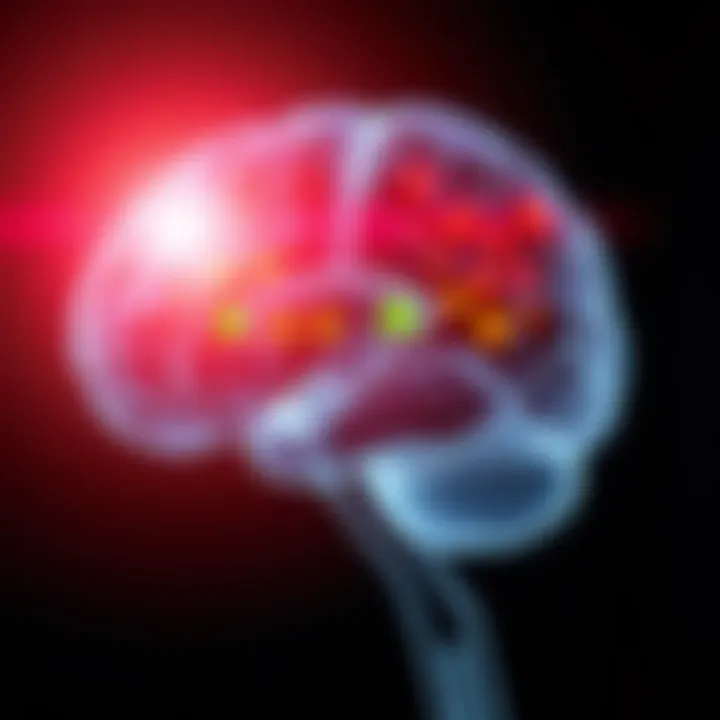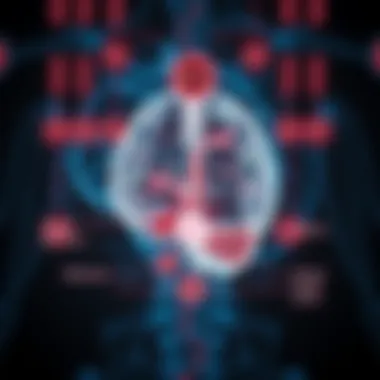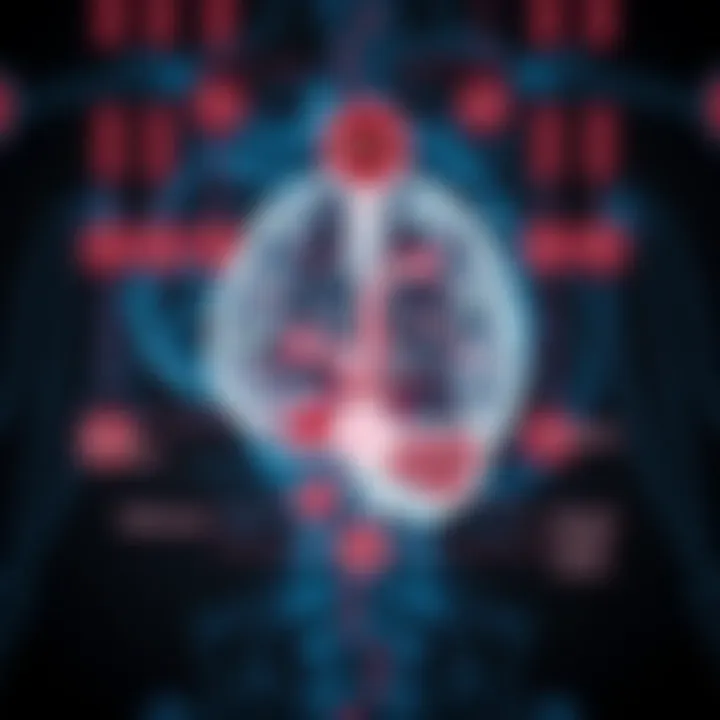Understanding Super Refractory Status Epilepticus


Research Overview
Super refractory status epilepticus (SRSE) is a critical and complex neurological condition that has garnered increasing attention in the medical community. It presents significant challenges in management due to its resistance to conventional treatments. The exploration of this subject is vital not only for the advancement of therapeutic strategies but also for improving patient outcomes and understanding the underlying mechanisms involved.
Summary of Key Findings
The examination of recent literature on SRSE highlights several key findings that contribute to our understanding of this condition:
- Clinical Presentation: SRSE is characterized by prolonged seizures that last longer than 24 hours and fail to respond to antiepileptic drugs (AEDs). Patients often present with various symptoms, including altered consciousness and autonomic instability.
- Pathophysiology: Current research suggests that the pathophysiological mechanisms involved in SRSE are multifaceted. Dysregulation of neurotransmitters, excitotoxicity, and inflammatory processes have all been implicated as underlying factors.
- Management Strategies: Various treatment modalities have been proposed, ranging from ketogenic diets to surgical interventions. Recent advancements in neuroprotective measures show promise but require further study.
Methodologies Employed
To understand SRSE more thoroughly, several methodologies have been adopted in research studies:
- Case Studies: Detailed case reports of patients with SRSE provide insight into the variable presentation and therapeutic responses.
- Clinical Trials: Randomized controlled trials (RCTs) have been conducted to assess the efficacy of new medications and interventions.
- Meta-analyses: Comprehensive reviews and meta-analyses synthesize research findings, providing a broader perspective on treatment outcomes and efficacy.
In-Depth Analysis
Detailed Examination of Results
The results from recent studies illustrate a spectrum of response to treatment in SRSE patients. While some may respond to a specific combination of AEDs, others may require alternative approaches such as intravenous anesthetic agents or neuromodulation techniques. The complex interplay of individual patient factors such as age, comorbidities, and the duration of seizure activity often determines outcomes. This highlights the need for customized management plans tailored to each patient.
Comparison with Previous Studies
When comparing findings with previous studies, it's clear that new strategies have emerged as our understanding deepens. Earlier interventions relied heavily on traditional AEDs, often leading to inadequate management. Recent evidence suggests that incorporating non-conventional treatments markedly enhances outcomes. Studies emphasizing the role of the ketogenic diet or the use of high-dose barbiturates indicate a shift towards more holistic and aggressive management of SRSE.
"New research is transforming the way we approach super refractory status epilepticus, paving the path for improved patient care and understanding."
Further Reading
To delve deeper into the topic of Super Refractory Status Epilepticus, consider visiting the following resources:
- Wikipedia on Status Epilepticus
- Britannica on Epilepsy
- PubMed for Research Articles
- National Institute of Neurological Disorders and Stroke
Understanding Status Epilepticus
Understanding Status Epilepticus (SE) is essential for grasping the complexities involved in its more severe form, Super Refractory Status Epilepticus (SRSE). Status Epilepticus is not just a fleeting medical emergency; it represents a crucial convergence of clinical urgency and the need for in-depth knowledge. This section lays the groundwork for its significance, starting with the foundational definitions and moving on to the crucial classifications that can guide diagnosis and treatment.
Defining Status Epilepticus
Status Epilepticus is generally defined as a state of continuous seizure activity lasting more than five minutes or recurrent seizures without the person regaining consciousness in between. It's important to note that this condition can take various forms, from convulsive to non-convulsive seizures, impacting how it is diagnosed and treated. Medical professionals must quickly recognize the signs to avert dire consequences such as permanent neurological damage or even death. The initial moments are crucial—like finding a needle in a haystack—but even more critical if one is to narrow down the myriad of potential underlying causes.
Classification of Status Epilepticus
Classifying Status Epilepticus typically revolves around two primary categories: convulsive and non-convulsive. Convulsive Status Epilepticus involves visible shaking and loss of consciousness, while non-convulsive can be subtler, often requiring advanced neuroimaging techniques to identify convincingly. Each classification serves a purpose, shaping how interventions are tailored. Factors like age, existing neurological conditions, and the duration of the seizure can influence the specific type. For those unfamiliar, it’s like categorizing various breeds of dogs—each has unique characteristics that require tailored care.
Importance of Timely Diagnosis
The importance of timely diagnosis in the context of Status Epilepticus cannot be overstated. Once the condition sets in, every tick of the clock echoes the urgency of an effective response. Delays can compound problems, escalating the likelihood of adverse outcomes. Rapid, accurate diagnosis opens the door to effective management strategies that can greatly improve prognosis. It also allows healthcare professionals to anticipate complications and implement preventive measures. In many ways, it’s akin to stopping a runaway train before it derails—a swift and informed response can mean the difference between recovery and significant long-term deficits.
Key Insight: A meticulous approach to understanding the various classifications and the critical nature of early diagnosis lays the groundwork for interventions that could save lives.
Understanding these fundamental elements of Status Epilepticus illuminates the path forward as we delve deeper into the specificities of Super Refractory Status Epilepticus, setting the stage for a comprehensive exploration of its complexities.
Super Refractory Status Epilepticus: An Overview
Super refractory status epilepticus (SRSE) represents a clinical emergency within the landscape of neurological disorders. It is essentially a form of status epilepticus that persists despite intensive treatment regimens. Understanding SRSE is paramount not just for the immediate management of affected patients, but for influencing long-term strategies in epilepsy treatment as a whole.
Defining Super Refractory Status Epilepticus
To define SRSE, one must first comprehend its context within status epilepticus. While any episode of status epilepticus lasts longer than five minutes, SRSE is characterized by seizures that last beyond 24 hours and do not respond to standard interventions, including benzodiazepines and antiepileptic drugs. This lack of response creates a cascade of complications, from neurological damage to increased mortality rates. By establishing the exact parameters of SRSE, clinicians can tailor their treatment approach with precision.
Having a clear cut definition is not just for semantic purposes. It guides the application of treatment protocols and predictive models of patient outcomes, which can be crucial for healthcare providers making real-time decisions.
Prevalence and Incidence Rates


The statistical landscape of SRSE paints a worrying picture. Research indicates that SRSE constitutes a significant proportion of all cases of status epilepticus. Prevalence rates can vary widely based on geographic and demographic factors, often ranging from 10% to upwards of 42% in some studies. The incidence of SRSE is particularly notable in populations with underlying neurological disorders, such as traumatic brain injury or prior epilepsy diagnoses.
Factors influencing these rates include:
- Age: Older adults may present with different patterns compared to younger patients.
- Underlying conditions: Co-morbidities such as vascular disease can increase risk.
- Geographical Variability: Certain areas might report higher rates due to socioeconomic or healthcare access issues.
Understanding these numbers is absolutely key. They signal the need for specialized care pathways and more robust healthcare infrastructure. Moreover, these statistics can influence further research into not just treatment protocols but preventive measures as well.
For instance, a meta-analysis published in Neurology indicates that earlier intervention correlates with better outcomes for patients facing SRSE, thus highlighting the urgency of identifying at-risk populations.
Clinical Manifestations
Understanding the clinical manifestations of Super Refractory Status Epilepticus (SRSE) is paramount in the patient care continuum. The expression of symptoms can be multifaceted and varies significantly between individuals, making it essential for clinicians and researchers alike to have a firm grasp of these elements. Identifying these manifestations not only aids in timely diagnosis but also in determining effective management strategies.
Identifying Symptoms of SRSE
The symptoms of SRSE can be particularly perplexing due to their overlap with other neurological disorders. However, they largely revolve around sustained seizures that can last for an extended duration. Often, these seizures may not exhibit the typical patterns one might expect. Generally, patients may experience prolonged convulsive seizures, non-convulsive seizures, or a combination of both. In some cases, there’s a confusion of consciousness or altered mental status, which can contribute to challenges in diagnosis and patient monitoring.
Considered as an emergency, a hallmark sign indicative of SRSE is the continuous state of seizures beyond 24 hours, which resists conventional therapies. A keen observation during this phase may also reveal autonomic instability, such as fluctuations in heart rate or blood pressure, which can further complicate the clinical picture.
- Common Symptoms of SRSE:
- Prolonged or repetitive seizures
- Altered consciousness
- Autonomic dysregulation
- Changes in behavior or cognitive function
Recognizing these symptoms promptly can be the difference between a critical intervention and a potential worsening of the patient’s condition. Thus, a thorough clinical history along with vigilant observation is key in the early identification of SRSE.
Neurological Assessments
When a patient presents with symptoms suggestive of SRSE, a comprehensive neurological assessment is necessary to elucidate the underlying issues. This process typically begins with a detailed history and physical examination to gauge the extent of the seizures and any associated neurological impairments.
A critical tool in these assessments is the electroencephalogram (EEG), which can display a range of neurologic abnormalities consistent with SRSE. EEG readings might reveal continuous spike-wave discharges or other patterns that indicate ongoing seizure activity even when the patient appears externally stable.
- Key Components of Neurological Assessments:
- History and Physical Exam: To document seizure types, duration, and prior interventions.
- EEG Monitoring: To identify seizure patterns and assess effectiveness of treatment.
- Neuroimaging: Occasionally, CT or MRI may be used to rule out structural lesions or abnormalities that could contribute to seizures.
The assessment also typically includes evaluating patient responsiveness and cognitive function, which can provide crucial insight into the prognosis and potential long-term effects of the condition.
"Early intervention in SRSE not only saves lives but can also drastically improve the long-term outcomes for patients."
Pathophysiology of SRSE
Understanding the pathophysiology of Super Refractory Status Epilepticus (SRSE) is crucial, as it lays the foundation for effective diagnosis and treatment. SRSE manifests when the neural circuits in the brain become unbalanced, resulting in seizure activities that do not respond to standard therapeutic approaches. This phenomenon can lead to significant morbidity and mortality if not addressed promptly.
The pathophysiological processes involved in SRSE are complex, involving a mixture of genetic, environmental, and biochemical factors. For instance, abnormalities in neurotransmitter systems, receptor functions, and ion channel activities can contribute to the development of this condition. Examining these elements can reveal insights into potential interventions that could improve patient outcomes.
Neurobiological Mechanisms behind SRSE
The neurobiological underpinnings of SRSE can be traced back to a multitude of mechanisms at play in the brain. One central aspect of this condition involves the dysregulation of excitatory and inhibitory neurotransmissions.
- Excitatory Neurotransmission: Glutamate serves as the primary excitatory neurotransmitter, and its overactivity may lead to uncontrolled neuronal firing. In SRSE, elevated levels of glutamate can significantly amplify seizure activity, making seizure cessation difficult to achieve.
- Inhibitory Neurotransmission: On the flip side, the role of gamma-aminobutyric acid (GABA) as the chief inhibitory neurotransmitter is also critical. Inadequate GABAergic activity can undermine normal inhibitory processes, pushing the balance towards increased excitability within neural circuits.
Apart from neurotransmitters, alterations in ion channels, such as voltage-gated sodium and calcium channels, can also exacerbate the problem. Aberrant ion channel activity can contribute to the hyperexcitability of neurons, fostering conditions ripe for SRSE. The interplay between both excitatory and inhibitory processes, along with other neurobiological elements, paints a holistic picture of the pathophysiology underlying this severe condition.
Role of Excitation and Inhibition
The balance between excitation and inhibition in the brain is like a finely tuned symphony; too much of one ends up drowning out the other, leading to neurological chaos. In SRSE, there’s often an overpowering swell of excitation that overwhelms the inhibitory signals. This imbalance is where the trouble begins.
- Excitation: Excessive excitatory signals hinder the brain’s ability to regain control over its electrical activity. When neurons continuously fire due to high levels of glutamate, seizing becomes more persistent and responses to treatment wane.
- Inhibition: Meanwhile, the effectiveness of GABA can become compromised. Factors like receptor desensitization, neuroinflammation, or even structural brain changes can lower GABA's ability to mediate inhibition. If GABAergic inhibition falters, it can exacerbate and prolong seizure episodes, leading to the label of super refractory.
The interaction between excitation and inhibition in patients experiencing SRSE reveals critical avenues for research and treatment strategies. Understanding these dynamics could assist healthcare professionals in tailoring patient-specific interventions that address the underlying pathophysiology, potentially leading to more effective outcomes.
"The intricate dance of excitatory and inhibitory signals is paramount in maintaining neuronal health and function, particularly in conditions as critical as SRSE."
Both neurobiological mechanisms and the role of excitation and inhibition form the backbone of our understanding of SRSE’s pathophysiology. This knowledge not only informs clinical practice but also drives ongoing research aimed at unraveling the complexities of this condition.


Diagnosis Criteria and Tools
Understanding the tools and criteria for diagnosing Super Refractory Status Epilepticus (SRSE) is paramount for a timely and accurate treatment plan. Proper diagnosis is not just about identifying the condition but also about gauging its severity and the required level of intervention. With the stakes being potentially life-threatening, efficient use of both clinical evaluations and diagnostic tools can make a significant difference.
Clinical Evaluation Methods
A thorough clinical evaluation is the first step in diagnosing SRSE. Medical professionals utilize a combination of patient history, physical examination, and caregiver insights to piece together the clinical picture. Factors like the duration of seizure activity, seizure type, and prior treatment response are crucial in this context.
- History Taking: Gathering detailed information from the patient (when possible) or caregivers regarding the onset of seizures, any incident triggers, and previous treatments forms the bedrock of the evaluation. Questions may range from "How often have the seizures occurred?" to "What medications have been tried and failed?"
- Physical Examination: Observing the patient's physical state can reveal secondary effects of prolonged seizure activity. Look for signs such as change in responsiveness, muscle tone, or the presence of any postictal symptoms (those that occur right after a seizure).
- Neurological Assessment: This involves tests to evaluate cognitive functions and motor abilities. Such evaluations can help determine the extent of neurological impairment, which may cause complications during management.
It's worthwhile to note that these methods should serve as a guide, and clinical suspicion can often lead to further diagnostic interventions.
Electroencephalogram (EEG) Relevance
The Electroencephalogram (EEG) plays an indispensable role in confirming a diagnosis of SRSE. Unlike standard seizures, which may have a defined end point, SRSE is marked by persistent seizure activity often undetectable during a routine examination.
Key Functions of EEG in SRSE:
- Real-Time Monitoring: Continuous EEG monitoring helps capture ongoing seizure activity, allowing clinicians to evaluate the frequency and duration of seizures in real-time. This data is crucial for adjusting treatment strategies effectively.
- Event Detection: An EEG can differentiate between generalized or focal seizures, which can have direct implications for the treatment approach. The identification of non-convulsive seizures is especially relevant, as these may not manifest overtly yet contribute to the persistent state of refractoriness.
- Guiding Treatment Decisions: By evaluating the EEG findings, clinicians can tailor pharmacological interventions, adjusting medication doses or switching drugs that may not have been effective thus far.
Continuous EEG monitoring stands as the gold standard in diagnosing and managing SRSE, allowing for real-time assessment of the patient's seizure activity.
Ultimately, the integration of clinical evaluations and advanced diagnostic tools like EEG can lead to timely interventions, which are vital, given that every minute lost can wear down a patient’s chances for recovery. By enhancing the diagnosis of SRSE, healthcare providers are in a better position to employ appropriate management tactics and improve patient outcomes.
Management Strategies
In the realm of managing super refractory status epilepticus (SRSE), the strategies employed can quite literally mean the difference between life and death. SRSE is notoriously resistant to treatment, so a well-thought-out management plan becomes essential. Not only does it aim to halt ongoing seizures, but it also seeks to minimize neurological damage and ensure the best possible quality of life for patients. Within this section, we break down the first-line treatment protocols, second-line and rescue therapies, and the nuanced role of anesthetics in managing this complex condition.
First-Line Treatment Protocols
When approaching the treatment of SRSE, the first-line strategies typically involve antiepileptic medications. Benzodiazepines like lorazepam and midazolam take center stage here. They are often administered intravenously due to their rapid onset of action, which is critical when dealing with a condition that can quickly spiral out of control. Additionally, phenytoin or fosphenytoin can be utilized for their sustained effects, although they may have limitations in terms of efficacy and side effects.
A common approach is to initiate treatment with a combination of these medications, ensuring that the maximum efficacy is achieved while balancing the risks of potential side effects. Administering barbiturates like phenobarbital has also been adopted in some protocols, particularly for those cases that do not respond to initial treatment. It's essential for clinicians to monitor the patient closely to adjust dosages or switch medications as necessary.
"The importance of quick intervention cannot be overstated—every minute matters in managing SRSE."
Second-Line and Rescue Therapies
For patients who do not show improvement with first-line treatments, second-line therapies become crucial. Levetiracetam and lacosamide have been gaining traction as viable options, especially due to their favorable side effect profiles. These drugs can be added to the treatment regimen to offer a more customized approach.
In some cases, ketamine might be introduced in a rescue capacity. This NMDA receptor antagonist not only acts as an anesthetic but also appears to exert anticonvulsant properties. Moreover, valproate can be considered when dealing with generalized seizures, bringing its unique pharmacodynamics to the fray.
The idea behind utilizing second-line therapies is not just to stop the seizures, but also to enhance control over the brain's electrical activity in response to ongoing treatment failures. However, this calls for a careful and often aggressive approach, balancing the risks of sedation and adverse effects against the urgency of the situation.
Use of Anesthetics in SRSE Management
Anesthetics hold a unique position in the management of SRSE. When seizures prove resistant to conventional medications, anesthetic agents can be exceptionally beneficial. Drugs such as thiopental, propofol, or midazolam can be employed to induce a state of deep sedation, effectively halting seizure activity and providing the brain a much-needed respite.
This approach isn’t without its complexities. Anesthetic management requires intensive monitoring and a dedicated environment like an Intensive Care Unit (ICU). The risks associated with deeper sedation are significant, including the potential for respiratory depression or hemodynamic instability, so healthcare providers must weigh these concerns.
It's a balancing act, ensuring that the interventions do not compromise overall patient safety. As we continually learn more about personalized medicine, these anesthetic options may even customize care to fit the individual patient's needs, enhancing outcomes in these dire scenarios.
Emerging Treatments and Research
The landscape of super refractory status epilepticus (SRSE) is ever-evolving, with emerging treatments and ongoing research providing a beacon of hope to both clinicians and patients alike. The relentless nature of SRSE, where traditional therapies often falter, has fueled an intense quest for new modalities that might improve outcomes. By investigating innovative approaches, we not only expand the therapeutic arsenal but also refine our understanding of the underlying mechanisms that drive this complex condition.
Neuromodulatory Techniques
Neuromodulation has gained a foothold in the management of various neurological disorders, including epilepsy. Its application in SRSE is particularly pertinent due to the intricate balancing act between excitation and inhibition in the brain, often disrupted in this condition.
- Deep Brain Stimulation (DBS): DBS involves implanting electrodes in specific brain regions to modulate neural activity. Early studies suggest that targeted stimulation in regions like the anterior nucleus of the thalamus can help alleviate seizures. However, the precise parameters for effective stimulation in SRSE are still being defined.
- Transcranial Magnetic Stimulation (TMS): TMS employs magnetic fields to stimulate nerve cells. Its non-invasive nature and potential to influence cortical excitability make it an interesting adjunctive treatment for patients with refractory seizures.
- Vagus Nerve Stimulation (VNS): This technique has shown promise in patients with epilepsy who do not respond well to medications. By providing periodic electrical stimulation to the vagus nerve, VNS can modulate seizure activity. Its role and efficacy in the context of SRSE, however, warrant further exploration.
The exploration of these neuromodulatory techniques is not just a therapeutic endeavor; it also presents a unique opportunity to dissect the neurobiological underpinnings of SRSE and find the key to unlocking better management strategies.
Potential Role of Cannabinoids


Cannabinoids, particularly those derived from Cannabis sativa, have garnered significant attention as potential therapeutic agents in the realm of epilepsy. The unique interaction of cannabinoids with the endocannabinoid system could offer new avenues for mitigation of seizures in SRSE.
- Mechanism of Action: Cannabinoids like cannabidiol (CBD) exhibit anticonvulsant properties. They may help balance neuronal excitability and provide neuroprotective effects, which is crucial in the hyper-excitable state of SRSE.
- Clinical Evidence: While the evidence is still emerging, some studies have indicated a reduction in seizure frequency with cannabinoid administration in treatment-resistant cases. However, the variability in patient responses necessitates large-scale clinical trials to establish consistent benefits.
- Ethical Considerations: The incorporation of cannabinoids into a treatment regimen for SRSE raises important ethical discussions. Factors such as regulatory status, long-term effects, and impacts on individual patients must be weighed carefully before widespread adoption.
"The exploration of cannabinoids in epilepsy signifies a blend of tradition and modern science, reflecting a shift towards more patient-centered therapeutic strategies."
For more information, you can refer to articles on Wikipedia - Epilepsy and The National Institute of Neurological Disorders and Stroke.
Long-Term Outcomes and Prognosis
Understanding the long-term outcomes and prognosis of super refractory status epilepticus (SRSE) is crucial for both medical professionals and caregivers. The ramifications of SRSE extend well beyond the immediate clinical setting, affecting a patient’s quality of life, neurological recovery, and the overall burden on healthcare systems. Insights into long-term outcomes can guide treatment strategies, inform families, and help integrate a holistic approach in managing patients recovering from SRSE.
Analyzing Prognostic Factors
The prognosis for patients with SRSE can be quite variable, influenced by several prognostic factors. These factors can be broadly categorized into clinical, neurological, and treatment-related variables.
- Duration of Seizures: The length of time that a patient experiences ongoing seizures is a significant predictor. Longer seizure durations often correlate with poorer outcomes. This relationship underscores the importance of rapid diagnosis and management.
- Age of the Patient: Younger patients may have a better recovery potential compared to older individuals. In children, neuroplasticity might play a role in recovery, while older adults may face additional health challenges that complicate their prognosis.
- Underlying Etiology: The reason for the SRSE, whether it stems from an acute brain injury, a prior history of epilepsy, or a metabolic derangement, has profound implications for outcomes. For instance, SRSE associated with an acute structural cause may have a more guarded prognosis.
- Initial Treatment Response: How a patient initially responds to first-line anti-seizure medications can also influence long-term outcomes. Those who remain refractory to multiple treatment attempts often have poorer prognoses.
- Neurological Assessment Scores: Tools such as the Glasgow Coma Scale can offer insights into a patient's neurological status prior to treatment, again impacting long-term outcomes significantly.
Understanding these prognostic factors is not just academic; it aids in informing the families about what to expect moving forward and helps formulate more individualized treatment plans to enhance recovery chances.
Impact on Quality of Life
Quality of life (QoL) for individuals post-SRSE is a concern that cannot be overlooked. Survivors may face a plethora of physical, emotional, and social challenges.
- Cognitive Function: Many patients experience cognitive deficits post-SRSE, which can interfere with their ability to perform daily tasks. Memory, attention, and executive functioning may be affected, leading to frustration and difficulties in rehabilitation.
- Emotional Well-Being: Anxiety, depression, and other mood disorders can surface in the aftermath of SRSE. The emotional toll may not just be a reaction to the condition, but may also stem from the impact of residual neurological issues on one's lifestyle.
- Social Interactions: A decline in social engagement can follow from both cognitive and emotional challenges. Patients may withdraw, affecting their relationships and support networks.
- Dependence on Caregivers: Many survivors of SRSE require ongoing support from caregivers, which can introduce a significant burden. Caregivers often experience their own stress, impacting the family dynamics.
- Physical Health Issues: Survivors may also grapple with seizure-related injuries or other health complications that can limit mobility and independence.
It’s important for healthcare providers to take a comprehensive approach that considers these dimensions of quality of life. Not only do medical interventions need addressing, but psychological support, rehabilitation, and social reintegration should also be cornerstones of long-term care strategies.
In summary, a thorough assessment of the long-term outcomes and prognosis for SRSE patients is vital. Understanding prognostic factors helps manage expectations and tailor effective management strategies, all while reinforcing the importance of treating the holistic needs of the individual.
For more information on SRSE prognosis and treatment, you can visit these resources: National Institutes of Health, Epilepsy Foundation, and Mayo Clinic.
Ethical Considerations
When delving into the complex realm of Super Refractory Status Epilepticus (SRSE), one cannot overlook the weighty ethical considerations that accompany its management. The treatment of SRSE poses multifaceted dilemmas involving aggressive interventions, potential side effects, and the overall quality of life for individuals afflicted with this condition. Grasping these ethical dimensions is critical not just for medical practitioners, but also for families navigating these challenging waters.
The essence of ethical consideration in SRSE often revolves around balancing the benefits of aggressive treatment against the risks and burdens it may impose. In some extreme cases, patients may undergo invasive procedures or be placed on high doses of anti-seizure medications with significant side effects. Thus, treatment decisions frequently encompass not solely clinical judgments but also moral imperatives that emphasize compassion and respect for patients' dignity.
"The ethical dimensions of aggressive treatment in healthcare often challenge us to think beyond diagnosis and prognosis and consider patient autonomy and quality of life."
Ethics of Aggressive Treatment
Aggressive treatment for SRSE can lead to a plethora of complications. Medications such as anesthetics or other potent anti-epileptic drugs are often used in extreme measures to control relentless seizures. While the primary goal is to curb immediate health hazards, clinicians must weigh the long-term implications of such decisions.
For instance:
- Risks of Compromise: Are we sacrificing a patient’s cognitive function or overall health for short-term seizure control?
- Burden to Family: Decisions around aggressive treatment can leave families grappling with the emotional strain and financial burdens that arrive alongside complex medical protocols.
It’s a delicate balancing act, one that demands a thoughtful approach, often served best through multidisciplinary discussions that include neurologists, ethicists, and family members. This can ensure a more holistic view, prioritizing not just survival but also well-being post-treatment.
Patient Consent and Autonomy
Informed consent is a cornerstone of medical ethics, playing an especially pivotal role within the context of SRSE. Patients, when able, should be part of the decision-making process regarding their treatment options. Even when patients are non-compliant or unable to communicate, respect for their previously stated wishes can guide ethical decisions.
In practice, patient consent can present challenges:
- Best Interest Standards: When patients cannot voice their preferences, surrogate decision-makers may need to step in, which can complicate what one views as being in the patient's best interest.
- Communication Effective: Clinicians must ensure that patients or their families grasp the complex nature of SRSE and the spectrum of treatment options available. This involves stripping away medical jargon and presenting information in a way that is genuinely accessible.
- Cultural Sensitivity: Individual values and cultural backgrounds can heavily influence treatment preferences. A holistic understanding of patient's backgrounds is important in tailoring the patient experience regarding consent.
To summate, the ethical considerations that surround Super Refractory Status Epilepticus extend far beyond clinical treatment; they enmesh the very fabric of our approach to patient care. They charge healthcare professionals with the critical responsibility of fostering not only optimal medical outcomes but also preserving the dignity and autonomy of patients caught in the throes of crisis.
Epilogue
The conclusion of this article spins the threads together, highlighting the intricate tapestry that comprises Super Refractory Status Epilepticus (SRSE). This condition, being an extreme form of status epilepticus, has become a significant concern within the medical community due to its difficult management and its long-reaching impact on patients' lives. By synthesizing the information presented, we underscore a few crucial elements that stand out.
First and foremost, the complex interplay of pathophysiological mechanisms associated with SRSE cannot be overstated. Gaining deeper insights into neurobiology and the factors exacerbating seizure activity provides a foundation for targeted therapeutic interventions.
Moreover, timely diagnosis remains pivotal. The article illustrates how a quick – and accurate – assessment can make a world of difference; it can change the trajectory of the patient’s journey, transcending the immediate medical response into long-lasting outcomes that significantly influence quality of life.
Additionally, the management strategies highlighted, encompassing both pharmacological and neuromodulatory approaches, serve as beacons of hope. The exploration of various treatment avenues indicates that while SRSE poses a substantial challenge, there are emerging options that may improve clinical outcomes and expand the possibilities for prolonging life and enhancing well-being.
Finally, the ethical considerations mentioned throughout signal the importance of patient autonomy and informed consent, ensuring that despite the complexities of treatment decisions, the voice of the patient remains central.
"In the labyrinth of medical practice, especially with conditions as intricate as SRSE, knowledge serves as the light guiding both professionals and patients towards understanding, managing, and ultimately living with this formidable challenge."















